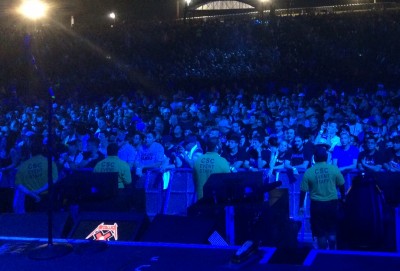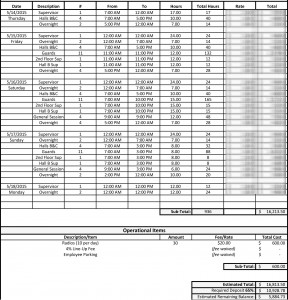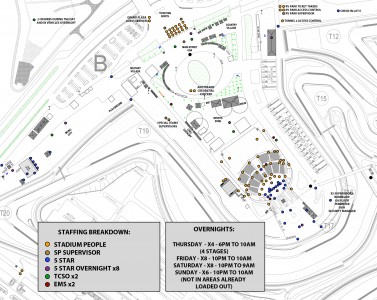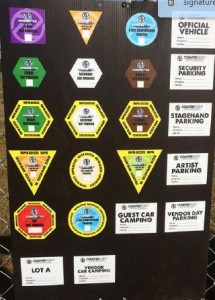Security and Safety Guide
Security at an event is absolutely essential regardless of the size. While smaller events may be able to get by with a couple of guards or just the event staff if it’s a free and small event, the vast majority of events and festivals require a comprehensive security plan. Below is a guide of how to create your own and what to look out for.
- Formulate a general security plan
- Coordinate with all affected departments as well as local governments if needed
- Take into account the type of event, length of event, demographics, and site related concerns
- Ensure that all of the necessary security and safety infrastructure and equipment – including, but not limited to: barricades, fencing, bike rack, fire extinguishers, first aid kits, proper lighting – are ordered and ready before the event begins (and that enough are there for load-in as well)
- Determine which security vendor(s) you will need
- Vet out your needs with multiple companies and chose based on how reliable and experienced their team is in that given city / for those types of events / at that particular venue
- Ensure they are licensed, bonded, and insured. It needs to be clear who is covered and how liability will be handled if a situation arises with a guest or guests.
Security Lined Up in the Pit for X Games 2015
- Create a deployment grid and/or dot map
- Dot maps are great visual aids to show exactly where you want all guards to be. Usually there will be a designation between a standard guard, a supervisor, overnight guards, EMTs, Police, and Fire Marshalls.
- Often, higher level bands will require prior approval of these maps, especially when it comes to access points around the stage and in the pit.
- Deployment Grid (with rate information blurred out) and Dot Map Examples:
- Coordinate with local law enforcement and determine how many officers will be appropriate for the size / nature of the event
- Usually they will all work in pairs, and some events may even require an on-site booking / holding area
- Coordinate all medical needs – EMTs / paramedics / nurses / ambulances
- Usually they will all work in pairs; some events may not need full life-saving support on-site and can suffice with nurses or EMTs; others must have paramedics and ambulances on site for optimum response times and guest service.
- Coordinate all fire safety needs – consult with the local fire marshall’s office (or the city special events department may also be a resource) to see what sort of event elements will trigger a fire watch (having a fire marshall oversee an area deemed hazardous or having to bypass a fire alarm and watch over the area in person) and what sort of permits the fire marshall’s office may require.
- Create an ingress / egress plan, taking into account any requirements by the fire department for blow out gates / emergency exits.
- Determine screening procedures at the front gates
- None
- Pat downs
- Bag checks
- Wands
- Mags
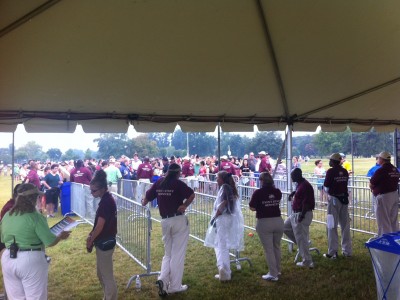
Security Supervisor going through the passboard with security staff as they line up and get ready to let guests inside the gates.
- Coordinate with Guest Services, Parking, and or the Site Operations departments to ensure staffing and infrastructure for all will allow you to execute your plan successfully
- Determine screening procedures at the front gates
- Create an Emergency Response Plan and an Emergency Action Plan
- These plans detail how to deal with emergencies that may include:
- Fire (view more details on types of fires)
- Inclement Weather
- Terrorism
- Coordinate with all affected parties and set a meeting to discuss in detail. Create a decision-making team of event leads that will make the final call on whether or not to cancel / postpone the event and/or evacuate.
- Consult with the Event Safety Alliance and their documentation to help create this.
- These plans detail how to deal with emergencies that may include:
- Create a Prohibited Items List / Make a FAQ area on your website for all security and related questions.
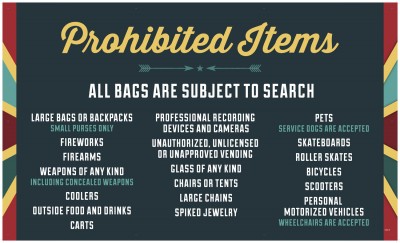
- Don’t be afraid to have some fun with it, too – Phish Festivals are famous for their funny FAQS:
-
YAYYY!
Backpacks
Hats (one fedora per crew)
Sunblock
Lighters
Cell phones
Sunglasses
Cigarettes
Small beach towel
Beach small towel
Fanny packs
The soul
The small of a woman’s back
The hanging curve ball
High fiber
Disposable cameras
Digital & Film cameras (non-pro)
Extra toilet paper (non-pro)BOOO!
NO Illegal drugs / drug paraphernalia
NO Weapons of any kind
NO Chains / Chain Wallets
NO Doubt
NO Beer kegs / hard liquor
NO Fireworks
NO Glass containers
No Diggity
NO Scrubs
NO Business like show business
NO Reply at all
NO Cars go
NO More drama
NO Rain
NO Unlicensed vending of any kind
-
- Don’t be afraid to have some fun with it, too – Phish Festivals are famous for their funny FAQS:
- Create and distribute security passboards
- Examples of various kinds:
This passboard clearly lists who gets into this particular access point with a clear “YES” or “NO”. Granted, some changes were made last minute in marker, but the general idea is there – make it as easy as possible for any security guard to properly enforce the access point with little to no room for other interpretation by guests.
Passboards for vehicles are also important, especially for camping festivals. This passboard, from CounterPoint 2015, clearly shows what vehicles need in order to be granted access to the various types of camping and backstage / production road access.
- Examples of various kinds:
